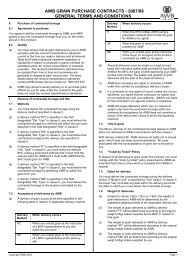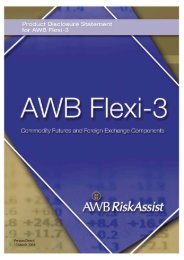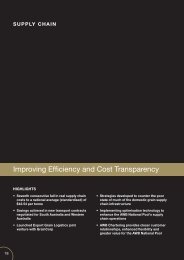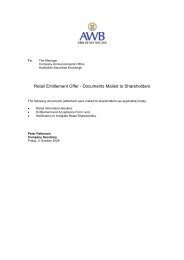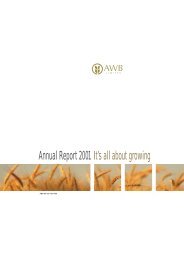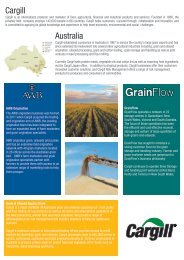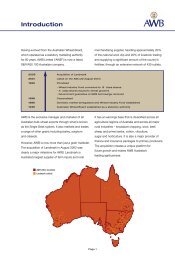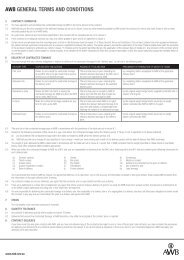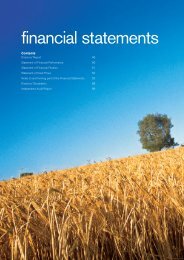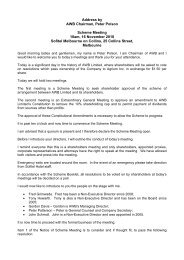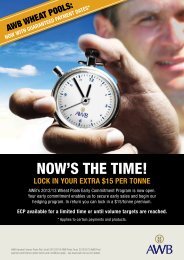Annual Report - AWB Limited
Annual Report - AWB Limited
Annual Report - AWB Limited
Create successful ePaper yourself
Turn your PDF publications into a flip-book with our unique Google optimized e-Paper software.
<strong>AWB</strong> LIMITED Notes to and forming part of the financial statements for the year ended 30 September 2008(iii) AASB 101 (revised) and AASB 2007-8 Presentation of FinancialStatements and consequential amendments to other AustralianAccounting Standards. (Applicable 1 October 2009)The revised standard introduces a statement of comprehensiveincome. Other revisions include impacts on the presentation of itemsin the statement of changes of equity, new presentation requirementsfor restatements or reclassifications of items in the financialstatements, changes in the presentation requirements for dividendsand changes to the titles of financial statements. These amendmentsare only expected to affect the presentation of the Group’s financialreport and will not have a direct impact on the measurement andrecognition of the amounts disclosed in the financial report. TheGroup has not determined at this stage whether to present a singlestatement of comprehensive income or two separate statements.(iv) AASB 2008-1 Amendments to Australian Accounting Standard- Share-based Payments: Vesting Conditions and Cancellations(Applicable 1 October 2009)The amendments clarify the definition of ‘vesting conditions’,introducing the term ‘non-vesting conditions’ for conditions other thanvesting conditions as specifically defined and prescribe the accountingtreatment of an award that is effectively cancelled because a nonvestingcondition is not satisfied. The Group has share-based paymentarrangements that may be affected by these amendments. However,the Group has not yet determined the extent of the impact, if any.(v) AASB 3 (revised) Business Combinations(Applicable reporting period beginning 1 October 2009)The revised standard introduces a number of changes to theaccounting for business combinations, the most significant of whichallows entities a choice for each business combination entered into- to measure a non-controlling interest in the acquiree either at itsfair value or at its proportionate interest in the acquiree’s net assets.This choice will effectively result in recording goodwill to 100% ofthe business (applying the fair value option) or recognising goodwillrelating to the percentage interest acquired. The changes applyprospectively. The Group may enter into business combinations duringthe next financial year and therefore may consider early adopting therevised standard. The Group has not yet assessed the impact of earlyadoption, including which accounting policy to adopt.(vi) AASB 127 (revised) Consolidated and Separate FinancialStatements and AASB 2008-3 Amendments to Australian AccountingStandards arising from AASB 3 and AASB 127 (Applicable reportingperiod beginning 1 October 2009)Under the revised standard, a change in the ownership interest of asubsidiary (that does not result in loss of control) will be accounted foras an equity transaction. If the Group changes its ownership interest inexisting subsidiaries in the future, the change will be accounted for asan equity transaction. This will have no impact on goodwill, nor will itgive rise to a gain or a loss in the Group’s income statement.(vii) AASB 2008-7 Amendments to International Financial <strong>Report</strong>ingStandards - Cost of an Investment in a Subsidiary, Jointly ControlledEntity or Associate (Applicable reporting period beginning1 October 2009)The distinction between pre and post acquisition dividends is nolonger required. However, the payment of such dividends requiresthe entity to consider whether there is an indicator of impairment.AASB 127 has also been amended to effectively allow the cost of aninvestment in a subsidiary, in limited reorganisations, to be based onthe previous carrying amount of the subsidiary (i.e. share of equity)rather than its fair value.Recognising all dividends received from subsidaries, jointly controlledentities and associates as income will likely give rise to greaterincome being recognised by the parent entity after adoption ofthese amendments. In addition, if the Group enters into any groupreorganisation establishing new parent entities, an assessmentwill need to be made to determine if the reorganisation meets theconditions imposed to be effectively accounted for on a ‘carry overbasis’ rather than at fair value.(viii) AASB 2008-8 Amendments to Australian Accounting Standards -Eligible Hedged Items (Applicable reporting period beginning1 October 2009)The amendment to AASB 139 clarifies how the principles underlyinghedge accounting should be applied when (i) a one-sided risk in ahedged item and (ii) inflation in a financial hedged item existed or waslikely to exist. The Group does not apply hedge accounting and is notexpected to be impacted by the amendment.AASB 127 has also been amended to effectively allow the cost of aninvestment in a subsidiary, in limited reorganisations, to be based onthe previous carrying amount to the subsidary (i.e. the share of equity)rather than its fair value.(aa) Significant accounting judgements, estimates and assumptionsThe preparation of financial statements requires management to makejudgements, estimates and assumptions that affect the applicationof accounting policies and the reported amounts of assets, liabilities,income and expenses. Actual results may differ from these estimates.Estimates and underlying assumptions are reviewed on an ongoingbasis. Revisions to accounting estimates are recognised in the periodin which the estimate is revised and in any future period affected.For the Group, the accounting estimates, judgements and assumptionsare principally in relation to:• Impairment of loans and advances - see policy (l), Notes 5 and 31;• Measurement of recoverable amounts of cash-generating unitscontaining goodwill - see policy (h) and Note 11;• Measurement of recoverable amount of non-current assets -see policy (g) and Note 12;• Fair valuation of financial instruments - see policy (s);• Non-consolidation of <strong>AWB</strong> National Pools - see policy (b); and• Recoverability of Deferred tax assets (including overseas tax losses)- see policy (r).(ab) Segment reportingA business segment is identified for a group of assets and operationsengaged in providing products or services that are subject to riskand returns that are different to those of other business segments.A geographical segment is identified when products or services areprovided within a particular economic environment subject to risksand returns that are different from those of segments operating inother economic environments.(ac) Fair valuesAll financial assets and liabilities are measured at fair value or dueto their short term maturities carrying value equates to fair value.See policy (s) for details on fair valuation methodology of derivativeinstruments.The estimated fair value of fixed loans and advances is based on thediscounted amount of estimated future cash flows and accordinglyhas not been adjusted for the provision for impairment. Estimatedcontractual cash flows for performing loans are discounted atestimated current credit spreads to determine fair value. For loanswith doubt as to collection, expected cash flows (inclusive of the valueof security) are discounted using a rate, which includes a premium foruncertainty of flows. For variable rate loans, fair value equates to thecarrying amount net of the provision for impairment.Fair values of interest bearing loans and borrowings held at amortisedcost are considered to equate to fair value as all borrowings are atfloating rates.66 www.awb.com.au



